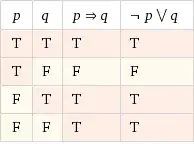
Why is (a) true if (if) is put in there?
Recall that a false statement implies everything. Remember that a statement of the form $$\text{If }P\text{ then }Q$$ is false only in the case when $P$ is true but $Q$ is false.
If $P$ is false then the implication is immediately true, and if $Q$ is true then the implication is immediately true. In the case of (a), both things occur.
See also:
Note that if we let $$P = 2 + 2 = 5,\; \text{ and}\;\;Q = \text{ triangles have three sides}$$
Then $\;$"$\text{If} \;P \;\text{ then}\;\; Q$"$\;$ is true whenever $\;P\;$ is false, or whenever $Q$ is true (in this case, it happens that both $P$ is false and $Q$ is true).
Equivalently $\;$"$\text{NOT}\; P \; \text{ OR}\;\; Q$"$\;$ is true whenever $\;P\;$ is false, or whenever $\;Q\;$ is true. (In this case, it happens that to be that $P$ is false and $Q$ is true.)
So there is a strong connection between the connectives "OR" = "$\lor$" and "IF (- THEN)"= "$\rightarrow$"; specifically:
$$\lnot P \lor Q \;\iff\; P \rightarrow Q$$
$\quad\quad\quad\quad\quad\quad\quad\quad\quad\quad\quad\quad\quad\quad\ $
In everyday usage, "if $A$ then $B$" suggests a causal or temporal relationship, e.g. $A$ causes $B$. If, over time, $A$ is always false, it would make no sense to say that $A$ causes $B$. There are no causal or temporal relationships in propositional logic, however. In propositional logic $A\rightarrow B$ is simply defined to be $\neg (A\wedge \neg B)$. If $A$ is false, then $\neg (A\wedge \neg B)$ must be true.
The logical statement if P then Q is only false is P if true and Q is false.
In this problem P is the statement 2+2=5, while Q is the statement "triangles have three sides". Clearly P is false but Q is true, yet the outcome of the logical statement if P then Q remains true by the line above.
see the section on logical implication